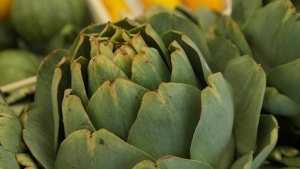Kelly Gibney's edible Christmas gifts
A healthier rocky road w/ goji berries & nuts
- 500 grams dark chocolate (I use 2 large bars of Whittakers Dark Ghana)
- ¾ cup goji berries
- ¾ cup pecans
- ¾ cup pistachio nuts
- ¾ coconut chips
- 1 cup puffed rice (could also use puffed millet)
- To garnish: Freeze-dried fruit (optional). I used raspberries and mandarins.
Melt the chocolate gently in a double boiler. Stir through the remaining ingredients. Line a 23cm square cake tin and press the mixture firmly in. Sprinkle with freeze-dried fruit if using. Place in the fridge to set for 2 hours. Use a hot knife to cut into pieces. Will last for 3 weeks in an airtight container.

Kelly Gibney's rocky road Photo: Kelly Gibney
Toasted tamari seeds
- Make 1 ½ cups
- ¾ cup sunflower seeds
- ½ cup pumpkin seeds
- ¼ cup sesame seeds
- 1 tablespoon tamari or soy sauce.
- Optional: ½ teaspoon of ground turmeric or ground cumin or hot smoked paprika
Place all the seeds in a dry skillet and place over medium heat. Gently toast the seeds for roughly 5 minutes, moving regularly, until lightly golden. If you are adding spices, do this in the last 2 minutes of cooking. Remove from the heat and add the tamari/soy sauce. Stir quickly to coat all of the seeds. Leave to cool completely before storing in an airtight jar for up to 6 weeks.
Nut butter
Making homemade nut butter can save you a lot of money, as store-bought varieties can be expensive. I've been making my own for a long time. I'm lucky to now have a powerful high-speed blender that can do it in just a few minutes, although I made it for years in my regular (non-fancy) food processor. It requires a little patience but the end result is beautiful. You'll be 'high-fiving' yourself when you make that first batch. Homemade nut butter also makes a great gift.
- 3 cups (420g) raw nuts - I most often use almonds or a cup each of almond, brazil and cashew nuts
- salt to taste
Pre-heat oven to 150c.
Spread nuts out evenly on a large ovenproof tray. Roast for 15-20 minutes. Set aside to cool for 10 minutes. Place the nuts in a food processor and start to run the machine.
Process the nuts for 10-20 minutes (depending on the machine), until the nut butter is absolutely smooth and creamy. You will need to take lots of breaks within this time to both to scrape the sides of the food processor bowl and to prevent the motor overheating.
The stages of making nut butter will appear as follows:
1. whole nuts
2. fine crumbs
3. sticky and solid mass
4. very coarse paste
5. smooth and creamy
DO NOT add any extra oil or other liquid. It is not needed. Perseverance is key. The nuts will release their own oils (given enough time) to make perfectly smooth nut butter. Add salt to taste at the end.

Kelly Gibney's nut butter Photo: Kelly Gibney
Homemade muesli
This is an easy base recipe to adapt to your favourite flavours.
- ¼ cup coconut oil or light flavoured olive oil
- 3 tablespoons honey
- 2 teaspoons vanilla essence
- zest of 1 orange
- 1 teaspoon ground cinnamon
- 3 cups rolled oats
- ¼ cup sesame seeds
- ½ cup sunflower seeds
- ½ cup pumpkin seeds
- 1 ½ cups nuts (I like to use almonds and cashews)
- 1 cup coconut chips or ½ cup dried coconut threads
- ¼ cup dried cranberries or goji berries
- ¼ cup chopped dried apricots
Preheat oven to 160 degrees Celsius. Warm the oil and honey until liquid. Add the vanilla essence, orange zest and cinnamon. Combine the oats, seeds, nuts and coconut. Pour over the oil and honey mixture and mix well. It can be easiest to do this with your hands.
Line two large oven-proof trays with baking paper and spread the mixture evenly on these. Bake for 15 minutes, watching closely so that it doesn't burn. Remove from the oven once during the cooking time to toss well.
Remove tray from the oven and mix through the dried fruit. Leave the muesli to cool completely before storing the airtight jars for up to 3 weeks.

Kelly Gibney's sauerkraut Photo: Kelly Gibney
Sauerkraut
Will make enough to fill 2-3 400ml jars
Don't be intimidated by this basic fermentation. It's very simple and I've been making it for years without ever experiencing a batch go bad or mouldy. As long as you keep the cabbage submerged in the liquid you'll have success.
I love to pair this with cheese, meat and avocado. Honestly though, I'll find a way to incorporate it into most meals!
- ½ medium (450g) green cabbage - remove the outer leaves
- ½ medium (450g) red cabbage - remove the outer leaves
- 5 teaspoons non-iodised salt (iodine inhibits the necessary bacteria)
- 2-3 clean jars - wash beforehand with very hot soapy water and leave to air dry
- large bowl (or bucket) for mixing
Cut the cabbage into quarters. Slice very thinly using a sharp knife or a mandolin. Place in the large bowl and sprinkle with salt - toss to disperse.
Using your (clean) hands, massage the cabbage vigorously for 5-10 minutes until it has softened, darkened and released lots of liquid. The longer you massage, the easier it is to pack into the jar.
Pack the softened cabbage and liquid VERY tightly into the jars leaving 3cm of space at the top (the cabbage will expand a little as the fermentation happens). There should be enough liquid for the cabbage to be fully submerged when pushed down tightly. Fermentation is an anaerobic activity (without oxygen) so it's important the cabbage comes in contact with as little air as possible and remains beneath the liquid to avoid contamination. The massaging process should leave you with plenty of liquid
Place the jar lids on lightly and leave in a cool, dark place. A cupboard or pantry is ideal.
Check the sauerkraut every day during that first week. Use a clean fork to keep the cabbage pushed firmly under the liquid. After a few days it should get bubbly. After a few more days it will start to smell and taste sour. At the 10-day mark start tasting it. Once you are happy with the flavour place it in the fridge and enjoy.
** I typically ferment my sauerkraut for 14-20 days. The process will take longer in winter and will be faster in summer. The thickness of the cabbage slices also affects the length of time it takes to ferment.


